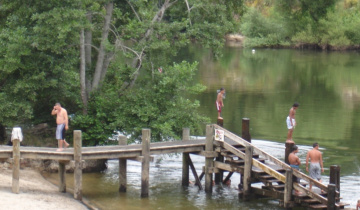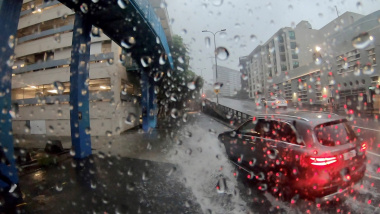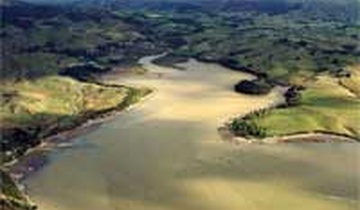“Nothing goes quite to plan, but usually goes as expected.”
With over 15 years working as a NIWA climate technician in the Pacific, Andrew Harper knows what to expect when working in the region.
He says plans might state 17 bags of cement, 42 metres of PVC conduit, 80 metres of heavy duty fencing materials and tools will be delivered in time for construction. “But the plan goes out the window when the barge carrying the supplies hasn’t left port due to a passing cyclone.
“There’s often limited local transport available so if you can find a vehicle to rent then that’s a bonus. On Vanuatu’s smaller islands, cash is required for accommodation, flights and food, which is fine until you learn that there is literally no place for foreigners to get cash without going back to the mainland.”
Local knowledge of project partner
Throw language difficulties into the mix and logistical operations that you might take for granted in New Zealand can seem like an insurmountable challenge in the Pacific.
All these challenges were faced earlier this year when NIWA started installing automatic weather stations (AWS) across Vanuatu. The challenges meant the work would not have been possible without the local knowledge of project partner, the Vanuatu Meteorology and Geohazards Department (VMGD).
Andrew Harper and colleague Marty Flanagan worked with six VMGD technicians and a small group of local men who provided manual labour. Andrew and Marty oversee the technical details, and training and coaching VMGD staff with the intention that they will be able to work autonomously on future projects.
Six of the stations are now installed, and three more have been shipped and will be installed in September. Another six are planned, probably for next year.

VMGD Technician Jeremy Bani (Left) and local Observation Officer Bradley Bani install cables on the weather station mast. [Photo: Dave Allen, NIWA]
NIWA technicians are available for ongoing support if required but the fundamental idea behind this work in Vanuatu, and so much of NIWA’s work in the Pacific, is to enable local organisations in each country to maintain the equipment and sustain their own operations independently.
Precise measurement of weather data
The AWS network is to be spread across almost 1000km from Aneityum in the south to Vanua Lava in the north.
Each AWS houses precision instruments that measure wind speed and direction, air and ground temperature, barometric pressure, humidity, rainfall and solar radiation. All of the instruments are installed in a highly specified manner in accordance with World Meteorological Organisation standards and procedures, to ensure consistent reporting.
Data from these instruments are sent to a centralised data archive via the internet. This seems simple enough on the surface but the key is ensuring all instruments are installed so that they work correctly and durably for many years with minimal maintenance requirements. Is the temperature sensor 1.2 metres above ground? Is the soil moisture sensor exactly 0.2 metres deep? Is the wind vane aligned true north? NIWA’s experience in this area is invaluable – it’s all specified and it all needs to be done accurately.
Vanuatu, like most Pacific nations, is highly vulnerable to natural disasters such as cyclones and droughts.

Improved climate data will help Vanuatu’s government departments better plan for climate related events. For example, Government Ministries of Fisheries and Agriculture will be able to plan water storage requirements with better seasonal forecasts for temperature and rainfall. [Photo: Dave Allen, NIWA]
High quality weather and climate information will help the country better prepare for these events.
However VMGD Project Coordinator Sam Tapo says the data will do so much more than this. “It will improve the livelihood of people living here in so many ways.”
Sam says the information will help Vanuatu’s government departments better plan for climate related events. For example, the Fisheries Department and the Ministry of Agriculture will be able to plan water storage requirements with better seasonal forecasts for temperature and rainfall. The tourism industry will benefit from a better understanding of weather patterns and how El Niño / La Niña impacts the area.
Much improved rainfall and temperature data will enable the Department of Health to provide better advice on mosquitoborne diseases. And the Department of Energy will be able to gain new insights on the potential for solar energy to replace some islands' reliance on diesel power generation.
The work is funded by the Global Environment Facility, and implemented by the Vanuatu Ministry of Climate Change and the United Nations Development Programme (UNDP), as part of a programme to build resilience through improved infrastructure. It’s a relatively small cost but has potential to return much more.

Mixing concrete – island style. The concrete foundations for the weather station will help the instruments hold up to extreme winds that are likley in future cyclones. [Photo: Dave Allen, NIWA]

Project Coordinator Sam Tapo (centre) prepares the concrete – mixed 'island style' on a tarpaulin. [Photo: Dave Allen, NIWA]

VMGD Technicians Jeremy Bani (left) and Loic Jimmy work on a colour coded patchwork of cabling to the Stevenson Screen – a standardised housing for instruments to measure air temperature, humidity and atmospheric pressure. [Photo: Dave Allen, NIWA]

With Tanna's only bank not able to dispense cash and credit card payments impossible, Marty Flanagan and Andrew Harper wait for money to be transferred from Auckland via Western Union. [Photo: Dave Allen, NIWA]
[This feature appeared in Water & Atmosphere 19]







